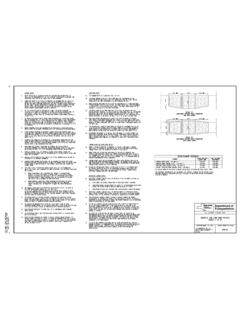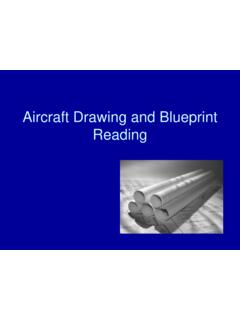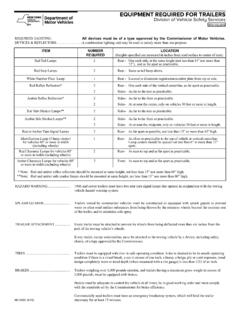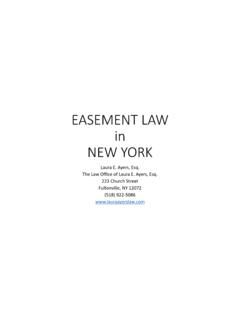Transcription of BALANCING OF ROTATING MASSES
1 BALANCING OF ROTATING MASSES DYNAMICS OF MACHINES ROTATING centerline : The ROTATING centerline being defined as the axis about which the rotor would rotate if not constrained by its bearings. (Also called the Principle Inertia Axis or PIA). Geometric centerline : The geometric centerline being the physical centerline of the rotor. When the two centerlines are coincident, then the rotor will be in a state of balance. When they are apart, the rotor will be unbalanced. Different types of unbalance can be defined by the relationship between the two centerlines. These include: Static Unbalance where the PIA is displaced parallel to the geometric centerline .
2 (Shown above) Couple Unbalance where the PIA intersects the geometric centerline at the center of gravity. (CG) Dynamic Unbalance where the PIA and the geometric centerline do not coincide or touch. The most common of these is dynamic unbalance. Causes of Unbalance: In the design of ROTATING parts of a machine every care is taken to eliminate any out of balance or couple, but there will be always some residual unbalance left in the finished part because of 1. slight variation in the density of the material or 2. inaccuracies in the casting or 3. inaccuracies in machining of the parts. Why BALANCING is so important?
3 1. A level of unbalance that is acceptable at a low speed is completely unacceptable at a higher speed. 2. As machines get bigger and go faster, the effect of the unbalance is much more severe. 3. The force caused by unbalance increases by the square of the speed. 4. If the speed is doubled, the force quadruples; if the speed is tripled the force increases by a factor of nine! Identifying and correcting the mass distribution and thus minimizing the force and resultant vibration is very very important BALANCING : BALANCING is the technique of correcting or eliminating unwanted inertia forces or moments in ROTATING or reciprocating MASSES and is achieved by changing the location of the mass centers.
4 The objectives of BALANCING an engine are to ensure: 1. That the centre of gravity of the system remains stationery during a complete revolution of the crank shaft and 2. That the couples involved in acceleration of the different moving parts balance each other. Types of BALANCING : a) Static BALANCING : i) Static BALANCING is a balance of forces due to action of gravity. ii) A body is said to be in static balance when its centre of gravity is in the axis of rotation. b) Dynamic BALANCING : i) Dynamic balance is a balance due to the action of inertia forces. ii) A body is said to be in dynamic balance when the resultant moments or couples, which involved in the acceleration of different moving parts is equal to zero.
5 Iii) The conditions of dynamic balance are met, the conditions of static balance are also met. In rotor or reciprocating machines many a times unbalance of forces is produced due to inertia forces associated with the moving MASSES . If these parts are not properly balanced, the dynamic forces are set up and forces not only increase loads on bearings and stresses in the various components, but also unpleasant and dangerous vibrations. BALANCING is a process of designing or modifying machinery so that the unbalance is reduced to an acceptable level and if possible eliminated entirely. BALANCING OF ROTATING MASSES When a mass moves along a circular path, it experiences a centripetal acceleration and a force is required to produce it.
6 An equal and opposite force called centrifugal force acts radially outwards and is a disturbing force on the axis of rotation. The magnitude of this remains constant but the direction changes with the rotation of the mass. a revolving rotor, the centrifugal force remains balanced as long as the centre of the mass of rotor lies on the axis of rotation of the shaft. When this does not happen, there is an eccentricity and an unbalance force is produced. This type of unbalance is common in steam turbine rotors, engine crankshafts, rotors of compressors, centrifugal pumps etc. The unbalance forces exerted on machine members are time varying, impart vibratory motion and noise, there are human discomfort, performance of the machine deteriorate and detrimental effect on the structural integrity of the machine foundation.
7 BALANCING involves redistributing the mass which may be carried out by addition or removal of mass from various machine members BALANCING of ROTATING MASSES can be of 1. BALANCING of a single ROTATING mass by a single mass ROTATING in the same plane. 2. BALANCING of a single ROTATING mass by two MASSES ROTATING in different planes. 3. BALANCING of several MASSES ROTATING in the same plane 4. BALANCING of several MASSES ROTATING in different planes STATIC BALANCING : A system of ROTATING MASSES is said to be in static balance if the combined mass centre of the system lies on the axis of rotation DYNAMIC BALANCING ; When several MASSES rotate in different planes, the centrifugal forces, in addition to being out of balance, also form couples.
8 A system of ROTATING MASSES is in dynamic balance when there does not exist any resultant centrifugal force as well as resultant couple. me 2 e G m CASE 1. BALANCING OF A SINGLE ROTATING MASS BY A SINGLE MASS ROTATING IN THE SAME PLANE Consider a disturbing mass m1 which is attached to a shaft ROTATING at rad/s. Let 111m mass the of gravity of centre the and shaft the of rotation of axis the between distancem mass the of rotation of radiusr== The centrifugal force exerted by mass m1 on the shaft is given by, )(rmFc11211 = This force acts radially outwards and produces bending moment on the shaft.
9 In order to counteract the effect of this force Fc1 , a BALANCING mass m2 may be attached in the same plane of rotation of the disturbing mass m1 such that the centrifugal forces due to the two MASSES are equal and opposite. Let, 222m mass the of gravity of centre the and shaft the of rotation of axis the between distancem mass the of rotation of radiusr== Therefore the centrifugal force due to mass m2 will be, (2)r mF222c2 = Equating equations (1) and (2), we get (3)rmrmorr mr mFF2211222121c2c1 === The product 22rm can be split up in any convenient way. As for as possible the radius of rotation of mass m2 that is r2 is generally made large in order to reduce the BALANCING mass m2.
10 CASE 2: BALANCING OF A SINGLE ROTATING MASS BY TWO MASSES ROTATING IN DIFFERENT PLANES. There are two possibilities while attaching two BALANCING MASSES : 1. The plane of the disturbing mass may be in between the planes of the two BALANCING MASSES . 2. The plane of the disturbing mass may be on the left or right side of two planes containing the BALANCING MASSES . In order to balance a single ROTATING mass by two MASSES ROTATING in different planes which are parallel to the plane of rotation of the disturbing mass i) the net dynamic force acting on the shaft must be equal to zero, the centre of the MASSES of the system must lie on the axis of rotation and this is the condition for static BALANCING ii) the net couple due to the dynamic forces acting on the shaft must be equal to zero, the algebraic sum of the moments about any point in the plane must be zero.









